From Tactical Urbanism Action to Institutionalised Urban Planning and Educational Tool: The Evolution of Park(ing) Day
Abstract
:1. Introduction
1.1. Context of Car-Free Movements
1.2. Park(ing) Day Origins as Tactical Urbanism Action
1.3. From Park(ing) Day to Institutionalised ‘Pavement to Parks’ Policy
1.4. Development of ‘Pavement to Parks’ as Permanent Park(ing) Day
2. Materials and Methods
- Desk research and secondary data analysis [39]. The analysis of data from press coverage and official press releases, as well as data provided by institutions, groups and activists responsible for the organisation of PD in respective cities, was undertaken. This included photographic archives provided by Wellington Sculpture Trust, the organising body for Wellington PD.
- Semi-structured expert interviews. The otherwise open format of interviews included several fixed components, including questions on: the overall number of PD editions in a certain city; the initiation of the event; the organisational structure; organisational and financial support from institutions (namely the city councils); the particular expert’s involvement; additional topics and themes (other than the original PD theme of quality of public space and dominance of cars). The intention was to interview at least one expert from each city in Poland and New Zealand in which PD was organised. The interview process planned for March–April 2020 was shaped by the consequences of national lockdowns in Poland and New Zealand. Most interviews were carried out via distance and included exchange of emails, instant messaging and phone calls.
- Research by design [40,41,42] and participant observation [38,43,44]. Authors of the article have been involved in organisation and design (K. Herman PD, Warsaw, Poland, 2009–2011) or design (K. Herman, M. Rodgers PD, Wellington 2020) of PD events and installations. Research through art and design is material-based research, development work and active research through practical experiments [42]. Participants in the design process are placed in the position to creatively exchange, collaborate and develop new knowledge together [45]. Both K. Herman and M. Rodgers have also analysed several other PD events as observers and casual participants employing the participant observation method, which allows the researcher to obtain first-hand knowledge and to ’get close to the data’, thereby developing the analytical, conceptual, and categorical components of explanation from the data itself [38].
3. Results
3.1. Case Study: Park(ing) Day in Poland
3.2. Case Study: Park(ing) Day in New Zealand
4. Discussion
4.1. The Institutionalisation of Park(ing) Day and the Criticism of Parklets
4.2. Tactical Urbanism and the Extension of Pedestrian Spaces During COVID19 Pandemic
4.3. Park(ing) Day: Towards an Educational Tool for Architects and Landscape Architects
5. Conclusions
Author Contributions
Funding
Acknowledgments
Conflicts of Interest
References
- Great Britain Ministry of Transport. Traffic in Towns: A Study of the Long Term Problems of Traffic Urban. Areas; Reports of the Steering Group and Working Group Appointed by the Minister of Transport; H.M. Stationery Office: London, UK, 1963. [Google Scholar]
- SCAFT Group. The SCAFT Guidelines 1968: Principles for Urban Planning with Respect to Road Safety; Statens Planverk and Statens Vägverk: Stockholm, Sweden, 1968. [Google Scholar]
- Jacobs, J. The Death and Life of Great American Cities; Vintage: New York, NY, USA, 1992. [Google Scholar]
- Qu, L.; Hasselaar, E. Making Room for People: Choice, Voice and Liveability in Residential Places; Techne Press: Amsterdam, The Netherlands, 2011. [Google Scholar]
- Verwer, D. Planning residential environments according to their real use by children and adults. Ekistics 1980, 47, 109–113. [Google Scholar]
- Hellema, D.; Wiebes, C.; Witte, T. Domestic measures. In The Netherlands and the Oil Crisis: Business as Usual; Amsterdam University Press: Amsterdam, The Netherlands, 2004; pp. 97–116. ISBN 9789053564851. [Google Scholar]
- Kingsley, P. How to Be Danish: A Journey to the Cultural Heart of Denmark; Short Books: London, UK, 2012; ISBN 9781780721347. [Google Scholar]
- Carless Days Introduced|NZHistory, New Zealand History Online. Available online: https://nzhistory.govt.nz/carless-days-introduced (accessed on 23 April 2020).
- Britton, E. Thursday: A Breakthrough Strategy for Reducing Car Dependence in Cities. Available online: https://web.archive.org/web/20120204173622/http://www.ecoplan.org/carfreeday/general/thursday.htm (accessed on 23 April 2020).
- Carlsson, C. Critical Mass: Bicycling’s Defiant Celebration; AK Press: Chico, CA, USA, 2002. [Google Scholar]
- Blickstein, S.; Hanson, S. Critical mass: Forging a politics of sustainable mobility in the information age. Transportation 2001, 28, 347–362. [Google Scholar] [CrossRef]
- Melia, S. On the road to sustainability: Transport and car-free living in Freiburg. In Report for WHO Healthy Cities Collaborating Centre; 2006. Available online: www.carfree.org.uk/038 (accessed on 23 April 2020).
- Wikipedia Contributors List of Car-Free Places. Available online: https://en.wikipedia.org/w/index.php?title=List_of_car-free_places&oldid=957350699 (accessed on 16 June 2020).
- Crawford, J.H. Carfree Cities; International Books: Dublin, UK; Discover Books: Toledo, OH, USA, 2000; ISBN 9789057270376. [Google Scholar]
- Nieuwenhuijsen, M.J.; Khreis, H. Car free cities: Pathway to healthy urban living. Environ. Int. 2016, 94, 251–262. [Google Scholar] [CrossRef] [PubMed]
- Littke, H. Revisiting the San Francisco parklets problematizing publicness, parks, and transferability. Urban For. Urban Green. 2016, 15, 165–173. [Google Scholar] [CrossRef]
- Ferreri, M. The seductions of temporary urbanism. Ephemera 2015, 15, 181–191. [Google Scholar]
- Merker, B. Taking place: Rebar’s absurd tactics in generous urbanism. In Insurgent Public Space. Guerrilla Urbanism and the Remaking of Contemporary Cities; Hou, J., Ed.; Roudedge: New York, NY, USA, 2010; pp. 45–58. ISBN 9780203093009. [Google Scholar]
- Coombs, G. Park(ing) day. Contexts 2012, 11, 64–65. [Google Scholar] [CrossRef]
- Chen, X.; Orum, A.M.; Paulsen, K.E. Introduction to Cities: How Place and Space Shape Human Experience; John Wiley & Sons: Hoboken, NJ, USA, 2018; ISBN 9781119167716. [Google Scholar]
- Endres, D.; Senda-Cook, S.; Cozen, B. Not just a place to park your car: Park(ing) as spatial argument. Argum. Advocacy 2014, 50, 121–140. [Google Scholar] [CrossRef]
- Chase, J.; Crawford, M.; Kaliski, J. Everyday Urbanism; Monacelli Press: New York, NY, USA, 2008; ISBN 9781580932011. [Google Scholar]
- Mike, L.; Anthony, G. Tactical Urbanism: Short-Term Action for Long-Term Change; Island Press: Washington, DC, USA, 2015. [Google Scholar]
- Houghton, K.; Foth, M.; Miller, E. Urban acupuncture: Hybrid social and technological practices for hyperlocal placemaking. J. Urban Technol. 2015, 22, 3–19. [Google Scholar] [CrossRef]
- Hou, J. Insurgent Public Space: Guerrilla Urbanism and the Remaking of Contemporary Cities; Routledge: New York, NY, USA, 2010; ISBN 9781136988028. [Google Scholar]
- Finn, D. DIY urbanism: Implications for cities. J. Urban. Int. Res. Placemaking Urban Sustain. 2014, 7, 381–398. [Google Scholar] [CrossRef]
- Prawata, A. Creative User Generated Urbanism. Procedia Soc. Behav. Sci. 2015, 184, 232–239. [Google Scholar] [CrossRef] [Green Version]
- Pascaris, J.P. Healing Neighbourhoods through Urban Acupuncture. Master’s Thesis, Ryerson University, Toronto, ON, Canada, 2012. [Google Scholar]
- Rebar Group. The Park(ing) Day Manifesto: User-Generated Urbanism and Temporary Tactics for Improving the Public Realm; Self-published (Rebar Group): San Francisco, CA, USA, 2011. [Google Scholar]
- Loukaitou-Sideris, A.; Brozen, M.; Callahan, C.K.; Brookover, I.; LaMontagne, N.; Snehansh, V. Reclaiming the Right-of-Way: A Toolkit for Creating and Implementing Parklets; UCLA Complete Streets Initiative, Luskin School of Public Affairs: Los Angeles, CA, USA, 2012. [Google Scholar]
- Birdsall, M. Parklets: Providing space for people to park... themselves. Inst. Transp. Eng. ITE J. 2013, 83, 36. [Google Scholar]
- Pratt, L. Divisadero Trial Parklet Impact Report (PDF); San Francisco Great Streets Project: San Francisco, CA, USA, 2010. [Google Scholar]
- Lavine, E. Spectacle in the new green city. Berkeley Plan. J. 2012, 25, 140–149. [Google Scholar] [CrossRef] [Green Version]
- Gould, S. Parklets: Tiny Parks with Big Impacts for City Streets; SvR Design: Seattle, WA, USA, 2012. [Google Scholar]
- Dai, D. From Parking to Park: Transportation Impacts and Value of Parklets; Congress for the New Urbanism: Chicago, IL, USA, 2013. [Google Scholar]
- Groundplay—When Imagination Goes Public. Available online: https://groundplaysf.org/ (accessed on 22 April 2020).
- Francis, M. A case study method for landscape architecture. Landsc. J. 2001, 20, 15–29. [Google Scholar] [CrossRef]
- Dandekar, H.C. Some uses and potentials of qualitative methods in planning. J. Plan. Educ. Res. 1986, 6, 42–49. [Google Scholar] [CrossRef] [Green Version]
- Johnston, M.P. Secondary data analysis: A method of which the time has come. Qual. Quant. Methods Libr. 2014, 3, 619–626. [Google Scholar]
- Devisch, O.; Hannes, E.; Trinh, T.A.; Leus, M.; Berben, J.; Hiến, Đ.T. Research-by-design framework for integrating education and research in an intercultural parallel design studio. Front. Archit. Res. 2019, 8, 406–414. [Google Scholar] [CrossRef]
- Megahed, Y. On research by design. ARQ Archit. Res. Q. 2017, 21, 338–343. [Google Scholar] [CrossRef] [Green Version]
- Hauberg, J. Research by Design—A research strategy. AE Rev. Lusófona Archit. Educ. 2011, 5, 46–56. [Google Scholar]
- Monteith, W. Participant Observation in Urban Arenas: Uncovering Hidden Rules in a Ugandan Marketplace; SAGE Publications, Ltd.: Thousand Oaks, CA, USA, 2014. [Google Scholar] [CrossRef]
- Yin, R.K. Participant-Observation and the Development of Urban Neighborhood Policy; RAND Corporation: Santa Monica, CA, USA, 1972. [Google Scholar]
- Roggema, R. Research by design: Proposition for a methodological approach. Urban Sci. 2016, 1, 2. [Google Scholar] [CrossRef]
- Matthew Passmore, R. PARK(ing) Day 2009. Available online: https://www.parking-net.com/parking-news/park-ing-day-2009 (accessed on 29 April 2020).
- Gap Filler|Gap Filler Is a Creative Urban Regeneration Initiative in Christchurch, New Zealand. Available online: https://gapfiller.org.nz/ (accessed on 16 May 2020).
- Osborne, N. Right to the City-Brisbane The Problem with Park(ing) Day. Available online: https://www.researchgate.net/publication/309666084_The_Problem_with_Parking_Day (accessed on 16 June 2020).
- Wikipedia Contributors Conflicts Involving Critical Mass. Available online: https://en.wikipedia.org/w/index.php?title=Conflicts_involving_Critical_Mass&oldid=926102450 (accessed on 5 May 2020).
- Davidson, M.M. Tactical Urbanism, Public Policy Reform, and “Innovation Spotting” by Government: From Park(ing) Day to San Francisco’s Parklet Program; Massachusetts Institute of Technology: Boston, MA, USA, 2013. [Google Scholar]
- PARK[ing] Day Highlights Importance of Urban Public Spaces|Newshub. Available online: https://www.newshub.co.nz/home/new-zealand/2019/09/park-ing-day-highlights-importance-of-urban-public-spaces.html (accessed on 5 May 2020).
- Olberding, J. Social Enterprise and Special Events; Taylor & Francis: Abingdon, UK, 2016; ISBN 9781317375494. [Google Scholar]
- Pratt, L. Parklet Impact Study; San Francisco Great Streets Project; City and County of San Francisco: San Francisco, CA, USA, 2011. [Google Scholar]
- Bela, J. User-generated urbanism and the right to the city. In Now Urbanism: The Future of City is Here; Routledge: New York, NY, USA, 2015; pp. 149–164. [Google Scholar]
- COVID-19—Current Cases. Available online: https://www.health.govt.nz/our-work/diseases-and-conditions/covid-19-novel-coronavirus/covid-19-current-situation/covid-19-current-cases (accessed on 5 May 2020).
- Moving around during the COVID-19 Outbreak. Available online: http://www.euro.who.int/en/health-topics/health-emergencies/coronavirus-covid-19/novel-coronavirus-2019-ncov-technical-guidance/coronavirus-disease-covid-19-outbreak-technical-guidance-europe/moving-around-during-the-covid-19-outbreak (accessed on 1 May 2020).
- Combs, T. Local Actions to Support Walking and Cycling During Social Distancing Dataset. Available online: http://pedbikeinfo.org/resources/resources_details.cfm?id=5209 (accessed on 5 May 2020).
- Reid, C. New Zealand First Country to Fund Pop-Up Bike Lanes, Widened Sidewalks During Lockdown. Forbes Magazine. Available online: https://www.forbes.com/sites/carltonreid/2020/04/13/new-zealand-first-country-to-fund-pop-up-bike-lanes-widened-sidewalks-during-lockdown/ (accessed on 5 May 2020).
- Crisis Creates Opportunity—Isthmus. Available online: http://isthmus.co.nz/thinking/crisis-creates-opportunity/ (accessed on 5 May 2020).
- NZ Transport Agency Innovating Streets—All updates|Waka Kotahi NZ Transport Agency. Available online: https://www.nzta.govt.nz/roads-and-rail/innovating-streets/ (accessed on 4 May 2020).
- Govt to Fund Temporary Cycleways and Footpaths Post COVID-19 Lockdown. Available online: https://www.beehive.govt.nz/release/govt-fund-temporary-cycleways-and-footpaths-post-covid-19-lockdown (accessed on 4 May 2020).
- Central City Framework. Available online: https://wellington.govt.nz/your-council/plans-policies-and-bylaws/policies/central-city-framework (accessed on 4 May 2020).
- Eva + Leeds Street Upgrage|NZ Institute of Landscape Architects. Available online: https://nzila.co.nz/showcase/eva-leeds-street-upgrage (accessed on 4 May 2020).
- Bezpieczne chodniki. Przenosimy Parkowanie na Jezdnię—Zarząd Dróg Miejskich w Warszawie. Available online: https://zdm.waw.pl/aktualnosci/bezpieczne-chodniki-przenosimy-parkowanie-na-jezdnie/ (accessed on 1 May 2020).
- Wilson, L. Park(ing) Day. Available online: http://www.chowhill.co.nz/chowhill-blog/park-ing-day (accessed on 14 May 2020).
- Salama, A.M. Spatial Design Education: New Directions for Pedagogy in Architecture and Beyond; Routledge: New York, NY, USA, 2016; ISBN 9781317051527. [Google Scholar]
- Morrow, R.; Brown, J.B. Live projects as critical pedagogies. In Live Projects: Designing with People; RMIT University Press: Melbourne, Australia, 2012. [Google Scholar]
- Canizaro, V.B. Design-build in architectural education: Motivations, practices, challenges, successes and failures. ArchNet-IJAR Int. J. Archit. Res. 2012, 6, 20. [Google Scholar]
- Folić, B.; Kosanović, S.; Glažar, T.; Fikfak, A. Design-build concept in architectural education. Archit. Urban Plan. 2016, 11, 49–55. [Google Scholar] [CrossRef] [Green Version]
- Gawryszewska, B.; Herman, K.; Myszka-Stąpór, I. Ogrody w Teorii i Praktyce Pracowni Sztuki Ogrodu i Krajobrazu; Stowarzyszenie Genius Loci: Warszawa, Polska, 2018; ISBN 9788395295607. [Google Scholar]
- Herman, K.; Sbarcea, M.; Panagopoulos, T. Creating green space sustainability through low-budget and upcycling strategies. Sustain. Sci. Pract. Policy 2018, 10, 1857. [Google Scholar] [CrossRef] [Green Version]
- Herman, K. Practices in low-budget landscape architecture. Ephemera 2015, 15, 279. [Google Scholar]
- Ifengspace (Ed.) Landscape Installation Art; Basheer Graphic Books: Singapore, 2013; ISBN 9789810755676. [Google Scholar]





| Method | Data/Information Source | Number of Instances/Objects |
|---|---|---|
| Desk research/secondary data analysis | Press coverage, archives, websites | 25 events in 7 cities in New Zealand |
| 49 events in 15 cities in Poland | ||
| Semi-structured expert interviews | Face to face meetings, phone calls and online exchanges (email, instant messaging) | 14 experts from 6 cities in New Zealand |
| 17 experts from 15 cities in Poland | ||
| Research by Design | Participation in the design and building process | 1 PD installation in Wellington, NZ(2020) |
| 4 PD installations in Warsaw, PL (2009–2011) | ||
| Participant observation | Observation, incidental conversation, engagement | 2 PD events in New Zealand (2019–2020) |
| 5 PD events in Poland (2009–2012) |
| 2009 | 2010 | 2011 | 2012 | 2013 | 2014 | 2015 | 2016 | 2017 | 2018 | 2019 | |
|---|---|---|---|---|---|---|---|---|---|---|---|
| Warszawa | 3 | 1 | 3 | 4 | i | 1 | |||||
| Kraków | 2 | 4 | 4 | 1 | 4 | 4 | c | ||||
| Poznań | 1 | 3 | 1 | ~30 | ~30 | ~40 | ~10 x | ||||
| Wrocław | x | 25 | |||||||||
| Łódź | 15 | 30 | ~25 ^ | ~25 ^ | ^ | ^ | |||||
| Lublin | 10 | 10 | 10 | 10 | |||||||
| Olsztyn | 10 | 18 | 3 | 1 | |||||||
| Gorzów Wlkp | 3 | 3 | |||||||||
| Szczecin | 5 | ~10 | x | ||||||||
| Jarocin | 10 # | ||||||||||
| Gdańsk | 2 | 4 | |||||||||
| Tczew | 3 | 3 | |||||||||
| Kalisz | 3 | ||||||||||
| Chojnice | 1 | ||||||||||
| Zielona Góra | 2 |
| 2009 | 2010 | 2011 | 2012 | 2013 | 2014 | 2015 | 2016 | 2017 | 2018 | 2019 | 2020 | |
|---|---|---|---|---|---|---|---|---|---|---|---|---|
| Wellington | 1 + | 25 | c | 22 * | 17 * | 19 * | 25 * | ~25 | 22 * | |||
| * in | ||||||||||||
| Auckland | 5 + | 10 + | 6 + | 6 + | 8 + | 8 + | 8 + | 50 s | 40 s | |||
| Christchurch | 1 | 1+ | 18 | 5 | ||||||||
| Queenstown | 1 | |||||||||||
| Dunedin | 1+ | |||||||||||
| Hamilton | 1 + | 1 | ||||||||||
| Tauranga and Mt. Maunganui | 3 | |||||||||||
| New Plymouth | 10 |
| Inspired Directly by the First PD (Lawn + Seat + Plants) | Publicity for a Cause | Art/Craft Created or Being Created | Encouraging Participation by Public | Performance | Recreation of Nature | |
|---|---|---|---|---|---|---|
| 2015 | 1 | 1 | 6 | 2 | 4 | 1 |
| 2016 | 1 | 1 | 7 | 5 | 2 | |
| 2017 | 1 | 7 | 7 | 2 | ||
| 2018 | 4 | 5 | 6 | 3 | 2 | |
| 2019 | 2 | 4 | 5 | 2 | ||
| 2020 | 1 | 9 | 7 |
© 2020 by the authors. Licensee MDPI, Basel, Switzerland. This article is an open access article distributed under the terms and conditions of the Creative Commons Attribution (CC BY) license (http://creativecommons.org/licenses/by/4.0/).
Share and Cite
Herman, K.; Rodgers, M. From Tactical Urbanism Action to Institutionalised Urban Planning and Educational Tool: The Evolution of Park(ing) Day. Land 2020, 9, 217. https://doi.org/10.3390/land9070217
Herman K, Rodgers M. From Tactical Urbanism Action to Institutionalised Urban Planning and Educational Tool: The Evolution of Park(ing) Day. Land. 2020; 9(7):217. https://doi.org/10.3390/land9070217
Chicago/Turabian StyleHerman, Krzysztof, and Maria Rodgers. 2020. "From Tactical Urbanism Action to Institutionalised Urban Planning and Educational Tool: The Evolution of Park(ing) Day" Land 9, no. 7: 217. https://doi.org/10.3390/land9070217






